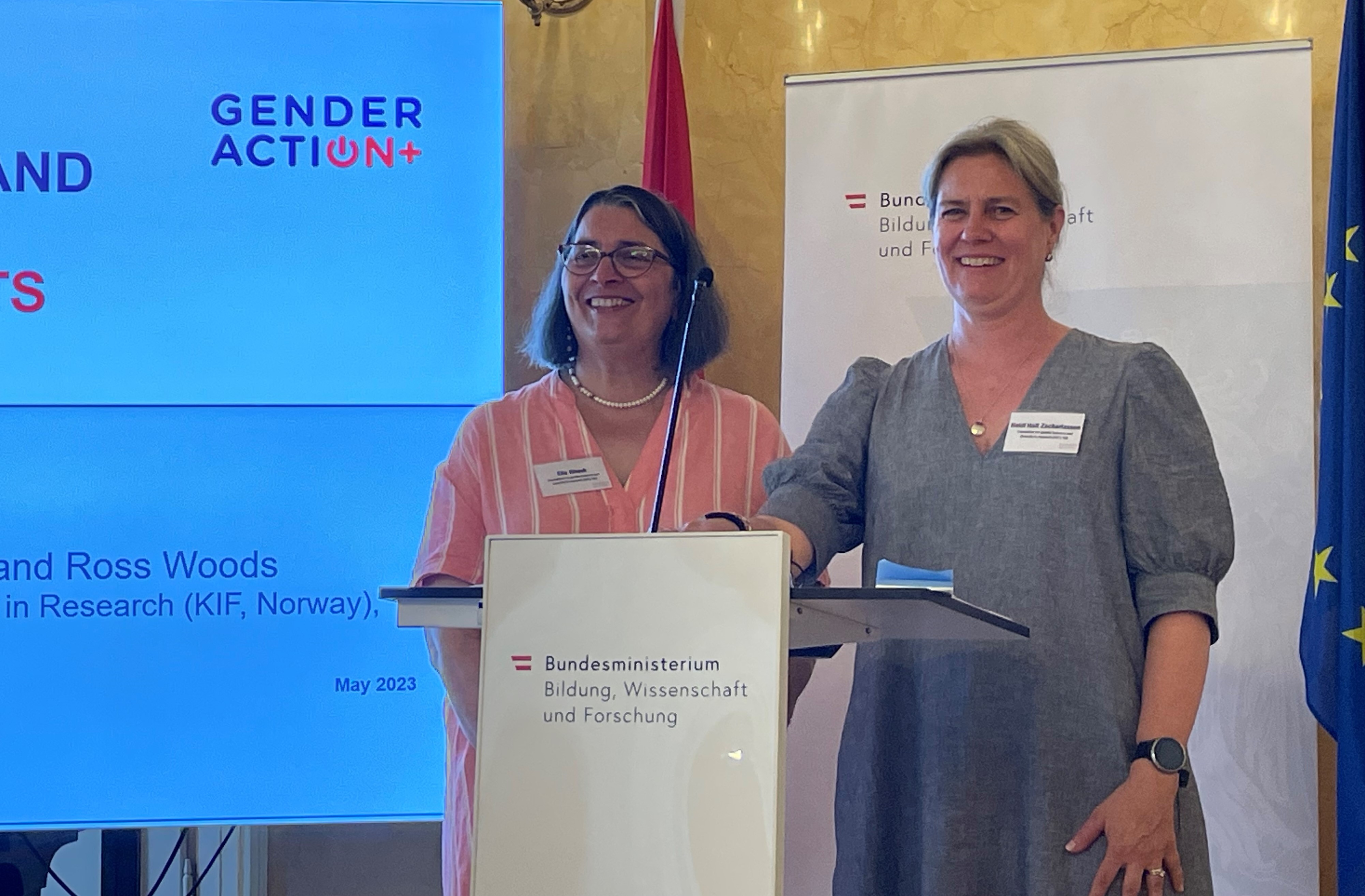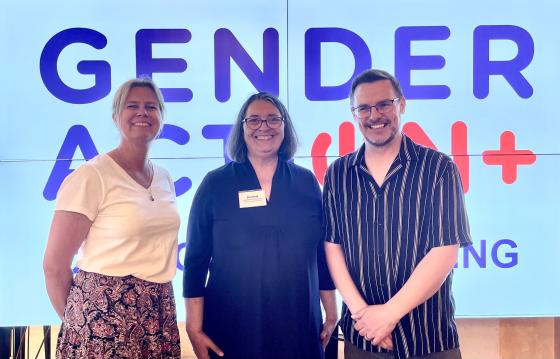At the start line for a broad understanding of equality
The laws and policies of many European countries include different grounds for discrimination. "Yet intersectional perspectives in research policy are still at an early stage," says Heidi Holt Zachariassen, co-author of a recent report.
The Benchmarking report on terminology and policy on intersectionality was produced as part of the EU project GENDERACTIONplus.
The report was written by Heidi H. Zachariassen and Ella Ghosh, both members of the KIF Committee's secretariat, in addition to Ross Woods who is head of equality at the Higher Education Authority of Ireland.
"Reality is pushing for change”
Norway and Ireland are best in class when it comes to inclusion, diversity and intersectionality in politics and legislation, while Poland and Bulgaria, along with Denmark, are at the opposite end of the scale.
"The report is based on information from 15 national authorities and 20 research councils in Europe, all of which form part of the GENDERACTIONplus consortium," says Zachariassen.
Equality efforts have been expanded in EU research policy from only addressing gender to also including other grounds for discrimination, with inclusion, diversity and intersectionality. Zachariassen says that the knowledge acquired and the report will help put inclusion and intersectionality higher on the agenda in European research cooperation and on the European Commission's agenda.
The objective of the study was to identify which countries had national requirements for working with more grounds than just gender in legislation and policies for the university and university college sector. Furthermore, the study was to look at whether countries with such requirements also had an intersectional approach in their equality efforts.
The background for Benchmarking report on terminology and policy on intersectionality is that the European Commission seeks to place more priority on inclusion, diversity and intersectionality than before. Heidi Holt Zachariassen, Ella Ghosh and Ross Woods applied for this work package, which together with several other work packages constitutes the GENDERACTIONplus project.
Zachariassen and Ghosh represent the Committee for Gender Balance and Diversity in Research (the KIF Committee), while Woods is from the Higher Education Authority of Ireland. The purpose of the project is to obtain knowledge to provide input to the European Commission's research policy and to priority 5 in the European Research Area: gender equality. GENDERACTIONplus is one of two projects in Horizon Europe linked to ERA priority 5.
"Actually, reality is pushing this change. We don't just define ourselves as women or men. Other identity markers such as religion, ethnicity and social background must also be taken into account. Moreover, there are several gender categories."
"When you include several equality dimensions, it automatically reveals different types of discrimination and the disadvantages this brings. This reflects the reality of discrimination," she says.
"What did the assignment commissioned by the EU comprise?"
"The short version is that the EU wanted to find out whether European countries and research councils are rigged for this shift to a broader concept of equality. In other words, whether countries address society as it is today in the form of legal requirements and policies that will have an impact on universities, university colleges and research institutes."

Research councils lagging behind
One of the most important findings is that intersectional perspectives in research policy are at an initial level. This contrasts with the fact that more grounds for discrimination are clearly in place in many of the countries' legislation and policies, according to Zachariassen.
"The responses at the government level showed that several grounds for discrimination were in place and that intersectionality was mentioned. This is positive."
"But the situation was less positive in responses from research councils and in practice.”
"Can you explain what that means?"
"Practice was consistently poor here. The research councils had not included additional grounds for discrimination or a broader concept of equality such as intersectionality, and there were, for instance, few good examples of how legislation has led to good practices. This also applies to the countries with the best rankings."
Zachariassen says that the findings are consistent with other reports and surveys in the field.
"The findings were not that surprising. We must now work to provide good input for further policy development at European and national level."
"What are the benefits of including more dimensions of discrimination?"
"It's important to understand how different grounds for discrimination interact and create other forms of discrimination. Intersectionality is not just a theory, it’s also a tool."
As summarised in the report: An intersectional approach can design and implement policies that are more effective in tackling harassment and inequality in academia.
"Intersectionality looks at interaction, where no one type of equality is more important than another," says Zachariassen.
Conservative policy inhibits change
The main reason why some countries, such as Poland and Bulgaria, are poor at including intersectionality in research policy is that the countries’ policies are more traditional and conservative. Not that surprising. Yet it is somewhat surprising that we find Denmark in this group.
"The interesting thing is that Denmark does not have a national policy for the university and university college sector, and in practice, only gender discrimination is addressed. Here, it is the educational institutions themselves that must take action, and several do by, among other things, taking a broader approach to discrimination."
"Nor does Sweden take much account of anything other than gender when it comes to discrimination in the higher education sector."
"What data forms the basis for the knowledge you collected?"
"We mapped legislation and national policies through a simple check-off form where the countries themselves reported. We were also interested in the guidelines given to the research councils and whether they complied with EU requirements."
The three authors of the report also asked the countries and respondents to send excerpts from legislation and policy documents that referred to equality and discrimination. This, according to Zachariassen, was to sort the wheat from the chaff.
"Through this reporting, we obtained a basis for identifying whether policies and rules led to concrete measures. This is where we found the big gap, unfortunately. Policy and practice do not correspond."
"The positive thing is that the national guidelines are largely in place."
Towards intersectional perspectives
The question is then what the next step will be.
"It's key to implement policy gradually. This is how the authorities have been working in Norway. From gender to also including ethnic diversity. So we're already working on two dimensions. Furthermore, it is important to have a knowledge base for other forms of discrimination," says Zachariassen.
"How can things go wrong if we fail to incorporate intersectionality?"
"In the KIF Committee, we experience this for example when mapping ethnic diversity. There are different groups in this category: International employees, descendants of immigrants, national minorities and finally those who just migrate here. The picture immediately becomes fragmented. When we also include gender, we obtain even better information about both challenges and what might be suitable measures to strengthen career development in academia in relation to all of the above."
"The KIF Committee also sees social background as an important dimension in order to adapt efforts to meet the needs of the groups in different ways. By looking at different dimensions together, we obtain better information that enables us to identify particular challenges for the different groups and find good measures for change."
"With everything that the intersectional perspective on equality comprises, it goes without saying that the countries and research communities need a good knowledge base," says the senior adviser.
"How long will this take, do you think?"
"I think that we’ll experience some of the same things as we’ve seen in efforts to achieve gender balance and gender equality. When Horizon Europe in its time set gender perspectives and gender balance as a condition for obtaining research funding, many institutions got quickly to grips to put this in place. Money speeds up change."
"Does this mean that Horizon Europe stipulates intersectionality as a requirement in applications?"
"No, it's not required as yet. However, by incorporating intersectionality into different strategies and documents, the EU has given a strong signal that it is not only gender that forms part of equality efforts in research policy."
"Ross Woods from Ireland, and Ella Ghosh and I from Norway, are now working on summarising our work, and will provide input for further work, or policy recommendations, to the European Commission. We will also make recommendations to national authorities and research councils in the countries that participated in the survey."
"Not surprised"
Ross Woods, head of equality at the Higher Education Authority of Ireland, said the knowledge and conclusions were close to what he expected.
"How would you describe the process of gathering information and writing the report?"
"The survey was designed on the basis that intersectionality is included in higher education and research policies and legislation in Europe, and it was distributed to the project participants in the EU and associated countries," says Woods.
According to Woods, the report, which was written in a collaboration between the Higher Education Authority of Ireland and the KIF Committee in Norway, found that some countries demonstrated very much of an intersectional approach to their equality efforts, which enabled them to analyse policies and laws and draw conclusions.
"Were there any findings that surprised you?"
"Not really. We knew that there were few signs of progress in equality efforts in terms of intersectional perspectives being included in legislation and policy in European countries, and our findings confirmed this."
"Can you say something about how the ‘best’ countries stood out from the others?"
"I can only speak for Ireland. But in particular, recent national policy documents such as the 2nd National Review of Gender Equality and the Anti-Racism Principles for Irish Higher Education Institutions have a clear focus on intersectionality," he says.
The gender equality project GENDERACTIONplus stands for Gender Equality Network to Develop ERA Communities To coordinate Inclusive and sustainable policy implementation.
The projected started in June 2022, and is funded through the EU research programme Horizon Europe.
Under WP2 "Intersectionality and inclusion", Heidi Holt Zachariassen and Ella Ghosh of the KIF Committee and Ross Woods of the Higher Education Authority of Ireland are behind the report: Benchmarking report on terminology and policy on intersectionality.
Likestillingsprosjektet står for Gender Equality Network to Develop ERA Communities To coordinate Inclusive and sustainable policy implementation.
Here you may read about EU's criteria for gender equality plans (GEPs)



